Auditing in Context Report - LSBM207, Finance Module, University
VerifiedAdded on 2022/08/13
|10
|2442
|21
Report
AI Summary
This report provides a comprehensive analysis of auditing in context, addressing key aspects of the field. It begins by examining the need for qualified audit opinions in the case of Sanders Brothers, exploring ethical considerations and the role of the audit committee in maintaining independence. The report then delves into the differences between final and interim audits, using Somerset Co as a case study, and differentiates between audit and review engagements in terms of assurance levels. Finally, the report discusses the three types of audit risks—inherent, control, and detection—using Smith Phones as an example, and considers the implications of accepting a new audit client in light of ethical principles. The report draws on relevant literature and ethical guidelines to provide a thorough examination of auditing principles and practices.
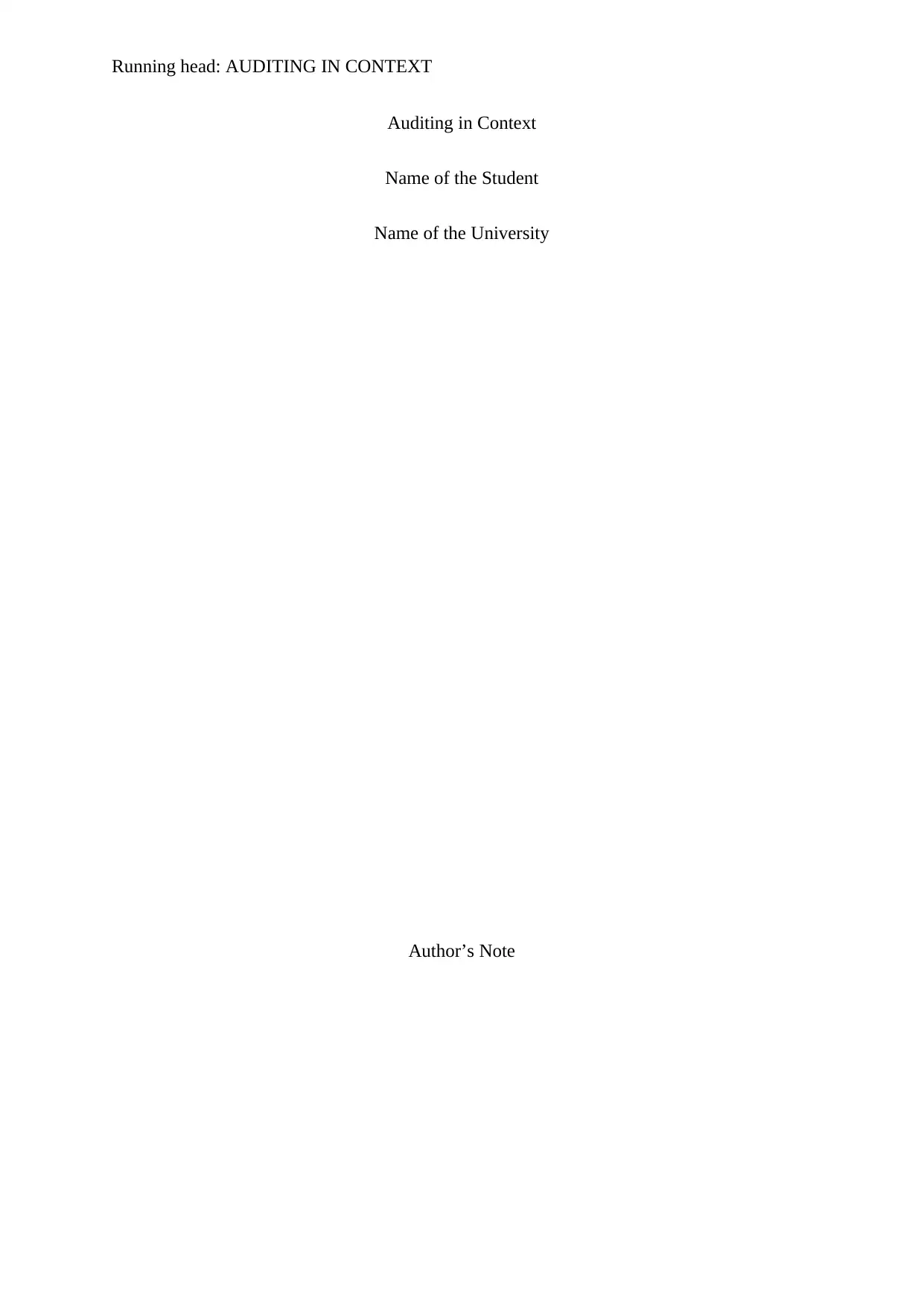
Running head: AUDITING IN CONTEXT
Auditing in Context
Name of the Student
Name of the University
Author’s Note
Auditing in Context
Name of the Student
Name of the University
Author’s Note
Paraphrase This Document
Need a fresh take? Get an instant paraphrase of this document with our AI Paraphraser
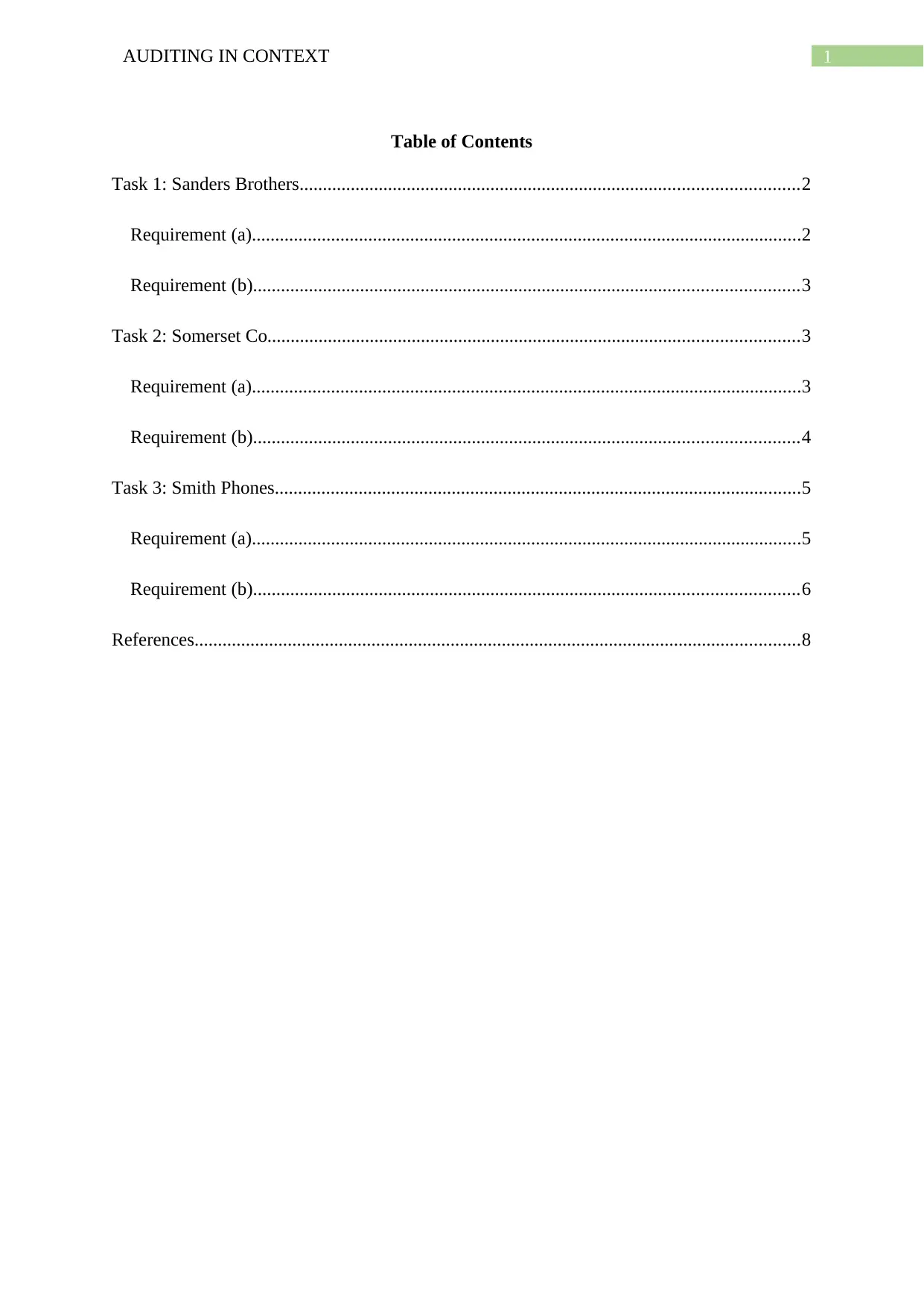
1AUDITING IN CONTEXT
Table of Contents
Task 1: Sanders Brothers...........................................................................................................2
Requirement (a)......................................................................................................................2
Requirement (b).....................................................................................................................3
Task 2: Somerset Co..................................................................................................................3
Requirement (a)......................................................................................................................3
Requirement (b).....................................................................................................................4
Task 3: Smith Phones.................................................................................................................5
Requirement (a)......................................................................................................................5
Requirement (b).....................................................................................................................6
References..................................................................................................................................8
Table of Contents
Task 1: Sanders Brothers...........................................................................................................2
Requirement (a)......................................................................................................................2
Requirement (b).....................................................................................................................3
Task 2: Somerset Co..................................................................................................................3
Requirement (a)......................................................................................................................3
Requirement (b).....................................................................................................................4
Task 3: Smith Phones.................................................................................................................5
Requirement (a)......................................................................................................................5
Requirement (b).....................................................................................................................6
References..................................................................................................................................8
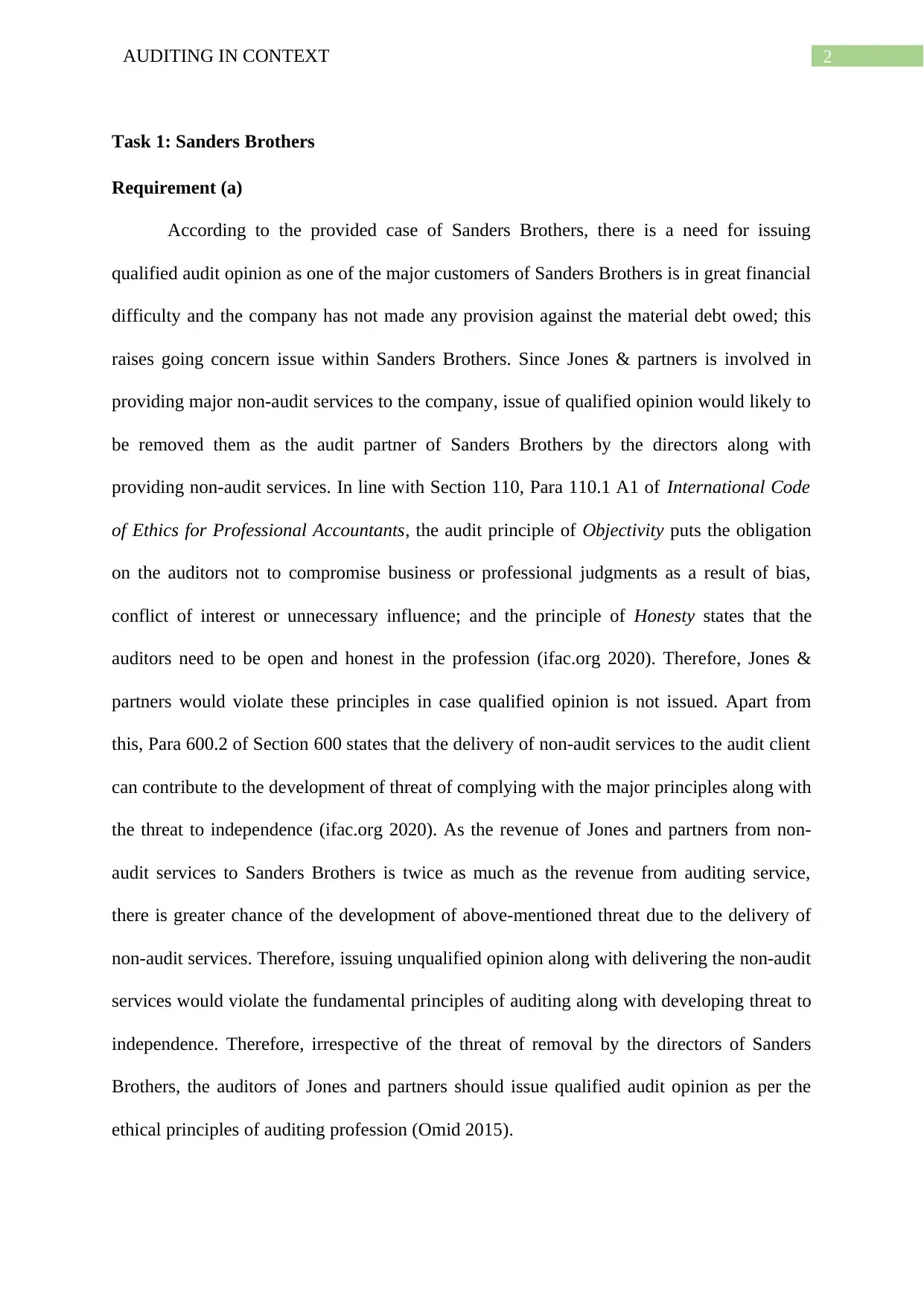
2AUDITING IN CONTEXT
Task 1: Sanders Brothers
Requirement (a)
According to the provided case of Sanders Brothers, there is a need for issuing
qualified audit opinion as one of the major customers of Sanders Brothers is in great financial
difficulty and the company has not made any provision against the material debt owed; this
raises going concern issue within Sanders Brothers. Since Jones & partners is involved in
providing major non-audit services to the company, issue of qualified opinion would likely to
be removed them as the audit partner of Sanders Brothers by the directors along with
providing non-audit services. In line with Section 110, Para 110.1 A1 of International Code
of Ethics for Professional Accountants, the audit principle of Objectivity puts the obligation
on the auditors not to compromise business or professional judgments as a result of bias,
conflict of interest or unnecessary influence; and the principle of Honesty states that the
auditors need to be open and honest in the profession (ifac.org 2020). Therefore, Jones &
partners would violate these principles in case qualified opinion is not issued. Apart from
this, Para 600.2 of Section 600 states that the delivery of non-audit services to the audit client
can contribute to the development of threat of complying with the major principles along with
the threat to independence (ifac.org 2020). As the revenue of Jones and partners from non-
audit services to Sanders Brothers is twice as much as the revenue from auditing service,
there is greater chance of the development of above-mentioned threat due to the delivery of
non-audit services. Therefore, issuing unqualified opinion along with delivering the non-audit
services would violate the fundamental principles of auditing along with developing threat to
independence. Therefore, irrespective of the threat of removal by the directors of Sanders
Brothers, the auditors of Jones and partners should issue qualified audit opinion as per the
ethical principles of auditing profession (Omid 2015).
Task 1: Sanders Brothers
Requirement (a)
According to the provided case of Sanders Brothers, there is a need for issuing
qualified audit opinion as one of the major customers of Sanders Brothers is in great financial
difficulty and the company has not made any provision against the material debt owed; this
raises going concern issue within Sanders Brothers. Since Jones & partners is involved in
providing major non-audit services to the company, issue of qualified opinion would likely to
be removed them as the audit partner of Sanders Brothers by the directors along with
providing non-audit services. In line with Section 110, Para 110.1 A1 of International Code
of Ethics for Professional Accountants, the audit principle of Objectivity puts the obligation
on the auditors not to compromise business or professional judgments as a result of bias,
conflict of interest or unnecessary influence; and the principle of Honesty states that the
auditors need to be open and honest in the profession (ifac.org 2020). Therefore, Jones &
partners would violate these principles in case qualified opinion is not issued. Apart from
this, Para 600.2 of Section 600 states that the delivery of non-audit services to the audit client
can contribute to the development of threat of complying with the major principles along with
the threat to independence (ifac.org 2020). As the revenue of Jones and partners from non-
audit services to Sanders Brothers is twice as much as the revenue from auditing service,
there is greater chance of the development of above-mentioned threat due to the delivery of
non-audit services. Therefore, issuing unqualified opinion along with delivering the non-audit
services would violate the fundamental principles of auditing along with developing threat to
independence. Therefore, irrespective of the threat of removal by the directors of Sanders
Brothers, the auditors of Jones and partners should issue qualified audit opinion as per the
ethical principles of auditing profession (Omid 2015).
⊘ This is a preview!⊘
Do you want full access?
Subscribe today to unlock all pages.

Trusted by 1+ million students worldwide
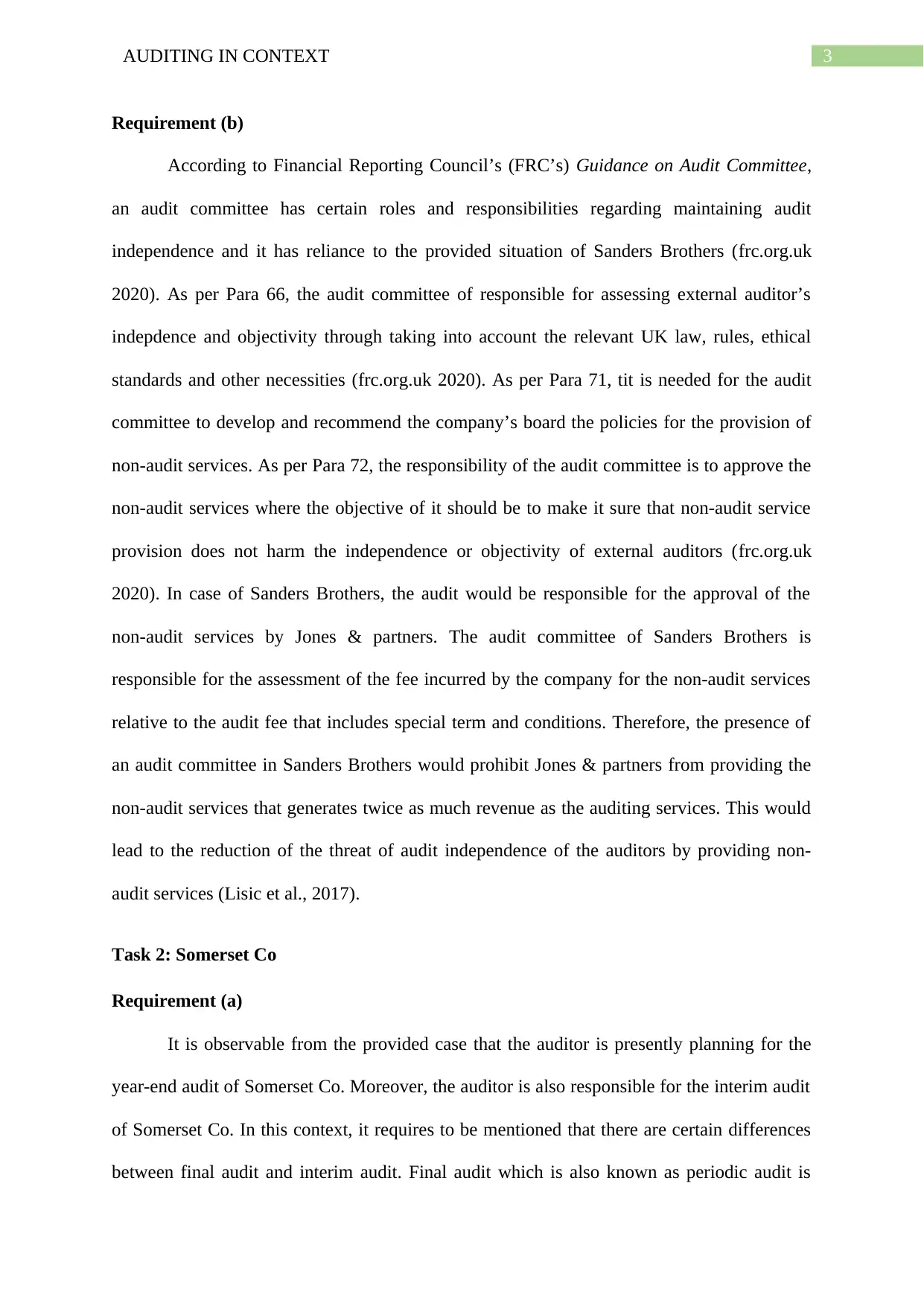
3AUDITING IN CONTEXT
Requirement (b)
According to Financial Reporting Council’s (FRC’s) Guidance on Audit Committee,
an audit committee has certain roles and responsibilities regarding maintaining audit
independence and it has reliance to the provided situation of Sanders Brothers (frc.org.uk
2020). As per Para 66, the audit committee of responsible for assessing external auditor’s
indepdence and objectivity through taking into account the relevant UK law, rules, ethical
standards and other necessities (frc.org.uk 2020). As per Para 71, tit is needed for the audit
committee to develop and recommend the company’s board the policies for the provision of
non-audit services. As per Para 72, the responsibility of the audit committee is to approve the
non-audit services where the objective of it should be to make it sure that non-audit service
provision does not harm the independence or objectivity of external auditors (frc.org.uk
2020). In case of Sanders Brothers, the audit would be responsible for the approval of the
non-audit services by Jones & partners. The audit committee of Sanders Brothers is
responsible for the assessment of the fee incurred by the company for the non-audit services
relative to the audit fee that includes special term and conditions. Therefore, the presence of
an audit committee in Sanders Brothers would prohibit Jones & partners from providing the
non-audit services that generates twice as much revenue as the auditing services. This would
lead to the reduction of the threat of audit independence of the auditors by providing non-
audit services (Lisic et al., 2017).
Task 2: Somerset Co
Requirement (a)
It is observable from the provided case that the auditor is presently planning for the
year-end audit of Somerset Co. Moreover, the auditor is also responsible for the interim audit
of Somerset Co. In this context, it requires to be mentioned that there are certain differences
between final audit and interim audit. Final audit which is also known as periodic audit is
Requirement (b)
According to Financial Reporting Council’s (FRC’s) Guidance on Audit Committee,
an audit committee has certain roles and responsibilities regarding maintaining audit
independence and it has reliance to the provided situation of Sanders Brothers (frc.org.uk
2020). As per Para 66, the audit committee of responsible for assessing external auditor’s
indepdence and objectivity through taking into account the relevant UK law, rules, ethical
standards and other necessities (frc.org.uk 2020). As per Para 71, tit is needed for the audit
committee to develop and recommend the company’s board the policies for the provision of
non-audit services. As per Para 72, the responsibility of the audit committee is to approve the
non-audit services where the objective of it should be to make it sure that non-audit service
provision does not harm the independence or objectivity of external auditors (frc.org.uk
2020). In case of Sanders Brothers, the audit would be responsible for the approval of the
non-audit services by Jones & partners. The audit committee of Sanders Brothers is
responsible for the assessment of the fee incurred by the company for the non-audit services
relative to the audit fee that includes special term and conditions. Therefore, the presence of
an audit committee in Sanders Brothers would prohibit Jones & partners from providing the
non-audit services that generates twice as much revenue as the auditing services. This would
lead to the reduction of the threat of audit independence of the auditors by providing non-
audit services (Lisic et al., 2017).
Task 2: Somerset Co
Requirement (a)
It is observable from the provided case that the auditor is presently planning for the
year-end audit of Somerset Co. Moreover, the auditor is also responsible for the interim audit
of Somerset Co. In this context, it requires to be mentioned that there are certain differences
between final audit and interim audit. Final audit which is also known as periodic audit is
Paraphrase This Document
Need a fresh take? Get an instant paraphrase of this document with our AI Paraphraser
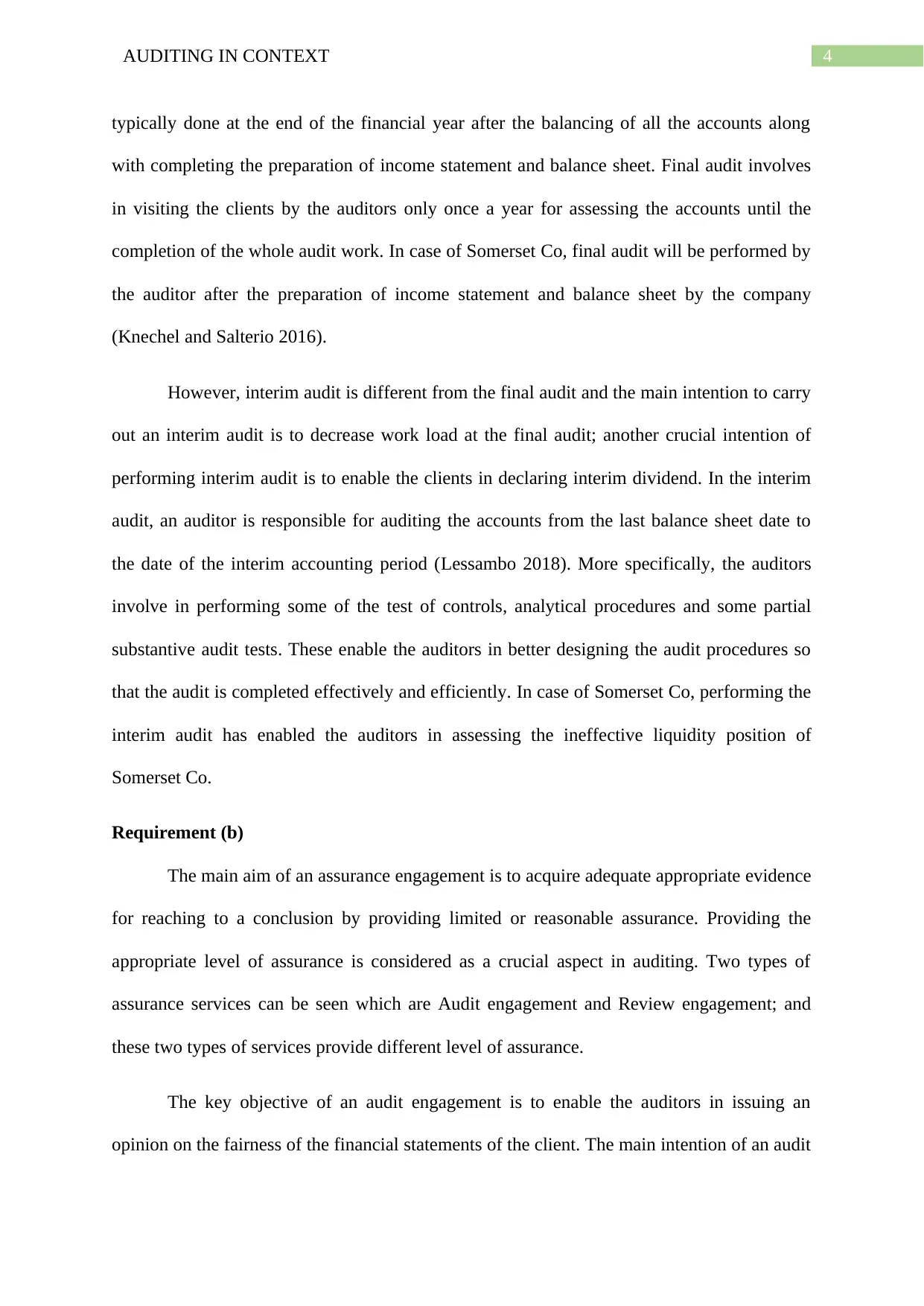
4AUDITING IN CONTEXT
typically done at the end of the financial year after the balancing of all the accounts along
with completing the preparation of income statement and balance sheet. Final audit involves
in visiting the clients by the auditors only once a year for assessing the accounts until the
completion of the whole audit work. In case of Somerset Co, final audit will be performed by
the auditor after the preparation of income statement and balance sheet by the company
(Knechel and Salterio 2016).
However, interim audit is different from the final audit and the main intention to carry
out an interim audit is to decrease work load at the final audit; another crucial intention of
performing interim audit is to enable the clients in declaring interim dividend. In the interim
audit, an auditor is responsible for auditing the accounts from the last balance sheet date to
the date of the interim accounting period (Lessambo 2018). More specifically, the auditors
involve in performing some of the test of controls, analytical procedures and some partial
substantive audit tests. These enable the auditors in better designing the audit procedures so
that the audit is completed effectively and efficiently. In case of Somerset Co, performing the
interim audit has enabled the auditors in assessing the ineffective liquidity position of
Somerset Co.
Requirement (b)
The main aim of an assurance engagement is to acquire adequate appropriate evidence
for reaching to a conclusion by providing limited or reasonable assurance. Providing the
appropriate level of assurance is considered as a crucial aspect in auditing. Two types of
assurance services can be seen which are Audit engagement and Review engagement; and
these two types of services provide different level of assurance.
The key objective of an audit engagement is to enable the auditors in issuing an
opinion on the fairness of the financial statements of the client. The main intention of an audit
typically done at the end of the financial year after the balancing of all the accounts along
with completing the preparation of income statement and balance sheet. Final audit involves
in visiting the clients by the auditors only once a year for assessing the accounts until the
completion of the whole audit work. In case of Somerset Co, final audit will be performed by
the auditor after the preparation of income statement and balance sheet by the company
(Knechel and Salterio 2016).
However, interim audit is different from the final audit and the main intention to carry
out an interim audit is to decrease work load at the final audit; another crucial intention of
performing interim audit is to enable the clients in declaring interim dividend. In the interim
audit, an auditor is responsible for auditing the accounts from the last balance sheet date to
the date of the interim accounting period (Lessambo 2018). More specifically, the auditors
involve in performing some of the test of controls, analytical procedures and some partial
substantive audit tests. These enable the auditors in better designing the audit procedures so
that the audit is completed effectively and efficiently. In case of Somerset Co, performing the
interim audit has enabled the auditors in assessing the ineffective liquidity position of
Somerset Co.
Requirement (b)
The main aim of an assurance engagement is to acquire adequate appropriate evidence
for reaching to a conclusion by providing limited or reasonable assurance. Providing the
appropriate level of assurance is considered as a crucial aspect in auditing. Two types of
assurance services can be seen which are Audit engagement and Review engagement; and
these two types of services provide different level of assurance.
The key objective of an audit engagement is to enable the auditors in issuing an
opinion on the fairness of the financial statements of the client. The main intention of an audit
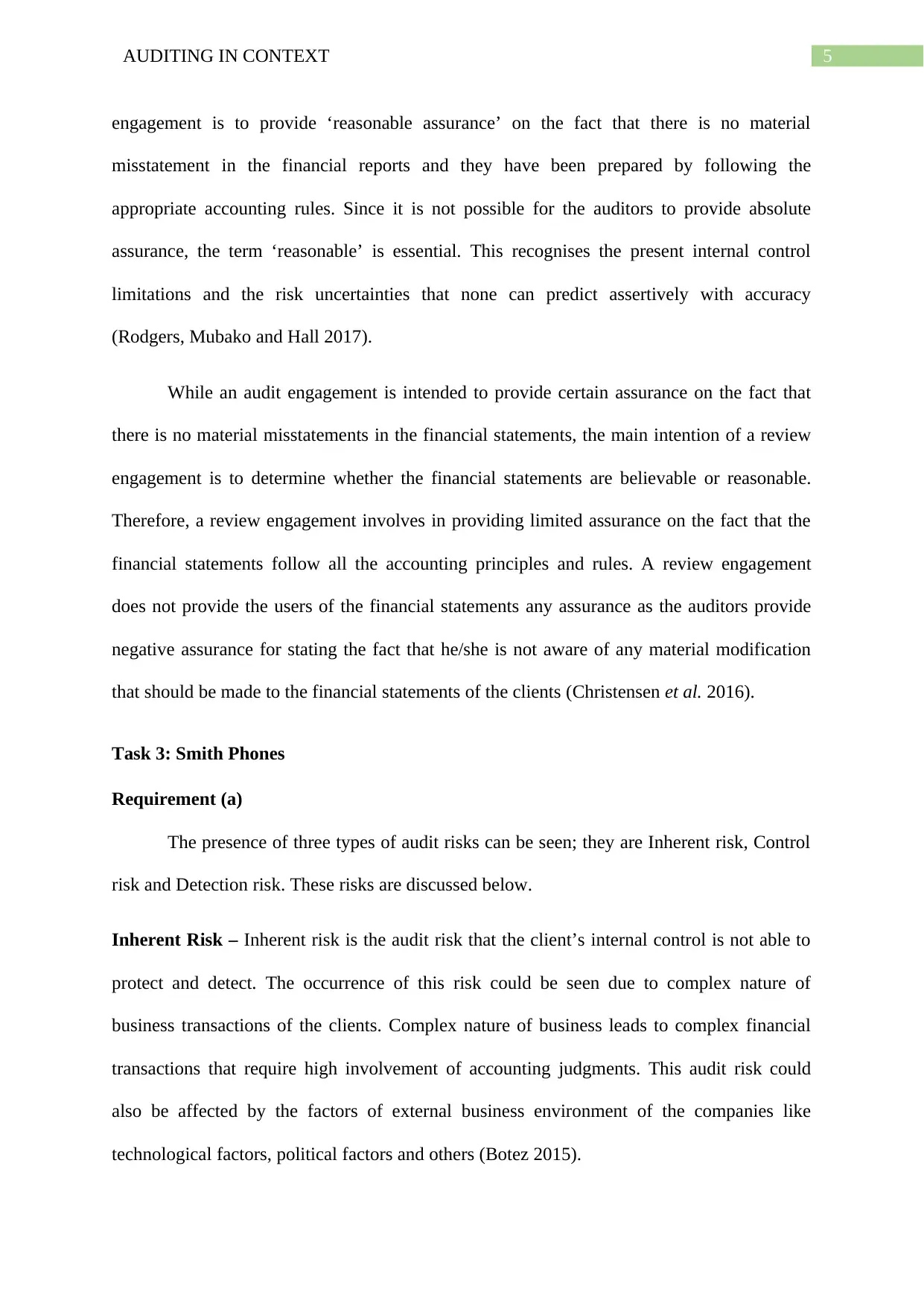
5AUDITING IN CONTEXT
engagement is to provide ‘reasonable assurance’ on the fact that there is no material
misstatement in the financial reports and they have been prepared by following the
appropriate accounting rules. Since it is not possible for the auditors to provide absolute
assurance, the term ‘reasonable’ is essential. This recognises the present internal control
limitations and the risk uncertainties that none can predict assertively with accuracy
(Rodgers, Mubako and Hall 2017).
While an audit engagement is intended to provide certain assurance on the fact that
there is no material misstatements in the financial statements, the main intention of a review
engagement is to determine whether the financial statements are believable or reasonable.
Therefore, a review engagement involves in providing limited assurance on the fact that the
financial statements follow all the accounting principles and rules. A review engagement
does not provide the users of the financial statements any assurance as the auditors provide
negative assurance for stating the fact that he/she is not aware of any material modification
that should be made to the financial statements of the clients (Christensen et al. 2016).
Task 3: Smith Phones
Requirement (a)
The presence of three types of audit risks can be seen; they are Inherent risk, Control
risk and Detection risk. These risks are discussed below.
Inherent Risk – Inherent risk is the audit risk that the client’s internal control is not able to
protect and detect. The occurrence of this risk could be seen due to complex nature of
business transactions of the clients. Complex nature of business leads to complex financial
transactions that require high involvement of accounting judgments. This audit risk could
also be affected by the factors of external business environment of the companies like
technological factors, political factors and others (Botez 2015).
engagement is to provide ‘reasonable assurance’ on the fact that there is no material
misstatement in the financial reports and they have been prepared by following the
appropriate accounting rules. Since it is not possible for the auditors to provide absolute
assurance, the term ‘reasonable’ is essential. This recognises the present internal control
limitations and the risk uncertainties that none can predict assertively with accuracy
(Rodgers, Mubako and Hall 2017).
While an audit engagement is intended to provide certain assurance on the fact that
there is no material misstatements in the financial statements, the main intention of a review
engagement is to determine whether the financial statements are believable or reasonable.
Therefore, a review engagement involves in providing limited assurance on the fact that the
financial statements follow all the accounting principles and rules. A review engagement
does not provide the users of the financial statements any assurance as the auditors provide
negative assurance for stating the fact that he/she is not aware of any material modification
that should be made to the financial statements of the clients (Christensen et al. 2016).
Task 3: Smith Phones
Requirement (a)
The presence of three types of audit risks can be seen; they are Inherent risk, Control
risk and Detection risk. These risks are discussed below.
Inherent Risk – Inherent risk is the audit risk that the client’s internal control is not able to
protect and detect. The occurrence of this risk could be seen due to complex nature of
business transactions of the clients. Complex nature of business leads to complex financial
transactions that require high involvement of accounting judgments. This audit risk could
also be affected by the factors of external business environment of the companies like
technological factors, political factors and others (Botez 2015).
⊘ This is a preview!⊘
Do you want full access?
Subscribe today to unlock all pages.

Trusted by 1+ million students worldwide
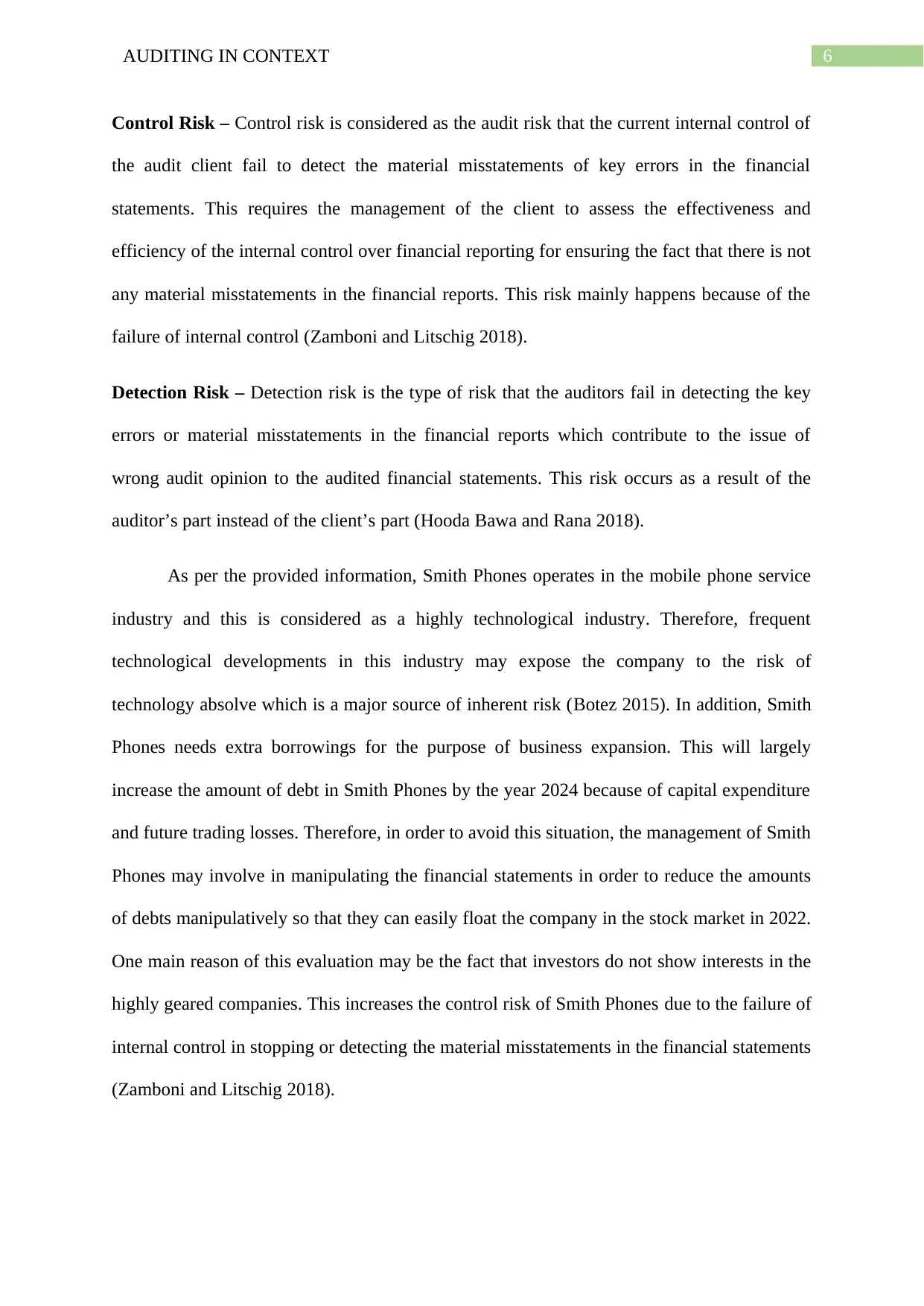
6AUDITING IN CONTEXT
Control Risk – Control risk is considered as the audit risk that the current internal control of
the audit client fail to detect the material misstatements of key errors in the financial
statements. This requires the management of the client to assess the effectiveness and
efficiency of the internal control over financial reporting for ensuring the fact that there is not
any material misstatements in the financial reports. This risk mainly happens because of the
failure of internal control (Zamboni and Litschig 2018).
Detection Risk – Detection risk is the type of risk that the auditors fail in detecting the key
errors or material misstatements in the financial reports which contribute to the issue of
wrong audit opinion to the audited financial statements. This risk occurs as a result of the
auditor’s part instead of the client’s part (Hooda Bawa and Rana 2018).
As per the provided information, Smith Phones operates in the mobile phone service
industry and this is considered as a highly technological industry. Therefore, frequent
technological developments in this industry may expose the company to the risk of
technology absolve which is a major source of inherent risk (Botez 2015). In addition, Smith
Phones needs extra borrowings for the purpose of business expansion. This will largely
increase the amount of debt in Smith Phones by the year 2024 because of capital expenditure
and future trading losses. Therefore, in order to avoid this situation, the management of Smith
Phones may involve in manipulating the financial statements in order to reduce the amounts
of debts manipulatively so that they can easily float the company in the stock market in 2022.
One main reason of this evaluation may be the fact that investors do not show interests in the
highly geared companies. This increases the control risk of Smith Phones due to the failure of
internal control in stopping or detecting the material misstatements in the financial statements
(Zamboni and Litschig 2018).
Control Risk – Control risk is considered as the audit risk that the current internal control of
the audit client fail to detect the material misstatements of key errors in the financial
statements. This requires the management of the client to assess the effectiveness and
efficiency of the internal control over financial reporting for ensuring the fact that there is not
any material misstatements in the financial reports. This risk mainly happens because of the
failure of internal control (Zamboni and Litschig 2018).
Detection Risk – Detection risk is the type of risk that the auditors fail in detecting the key
errors or material misstatements in the financial reports which contribute to the issue of
wrong audit opinion to the audited financial statements. This risk occurs as a result of the
auditor’s part instead of the client’s part (Hooda Bawa and Rana 2018).
As per the provided information, Smith Phones operates in the mobile phone service
industry and this is considered as a highly technological industry. Therefore, frequent
technological developments in this industry may expose the company to the risk of
technology absolve which is a major source of inherent risk (Botez 2015). In addition, Smith
Phones needs extra borrowings for the purpose of business expansion. This will largely
increase the amount of debt in Smith Phones by the year 2024 because of capital expenditure
and future trading losses. Therefore, in order to avoid this situation, the management of Smith
Phones may involve in manipulating the financial statements in order to reduce the amounts
of debts manipulatively so that they can easily float the company in the stock market in 2022.
One main reason of this evaluation may be the fact that investors do not show interests in the
highly geared companies. This increases the control risk of Smith Phones due to the failure of
internal control in stopping or detecting the material misstatements in the financial statements
(Zamboni and Litschig 2018).
Paraphrase This Document
Need a fresh take? Get an instant paraphrase of this document with our AI Paraphraser
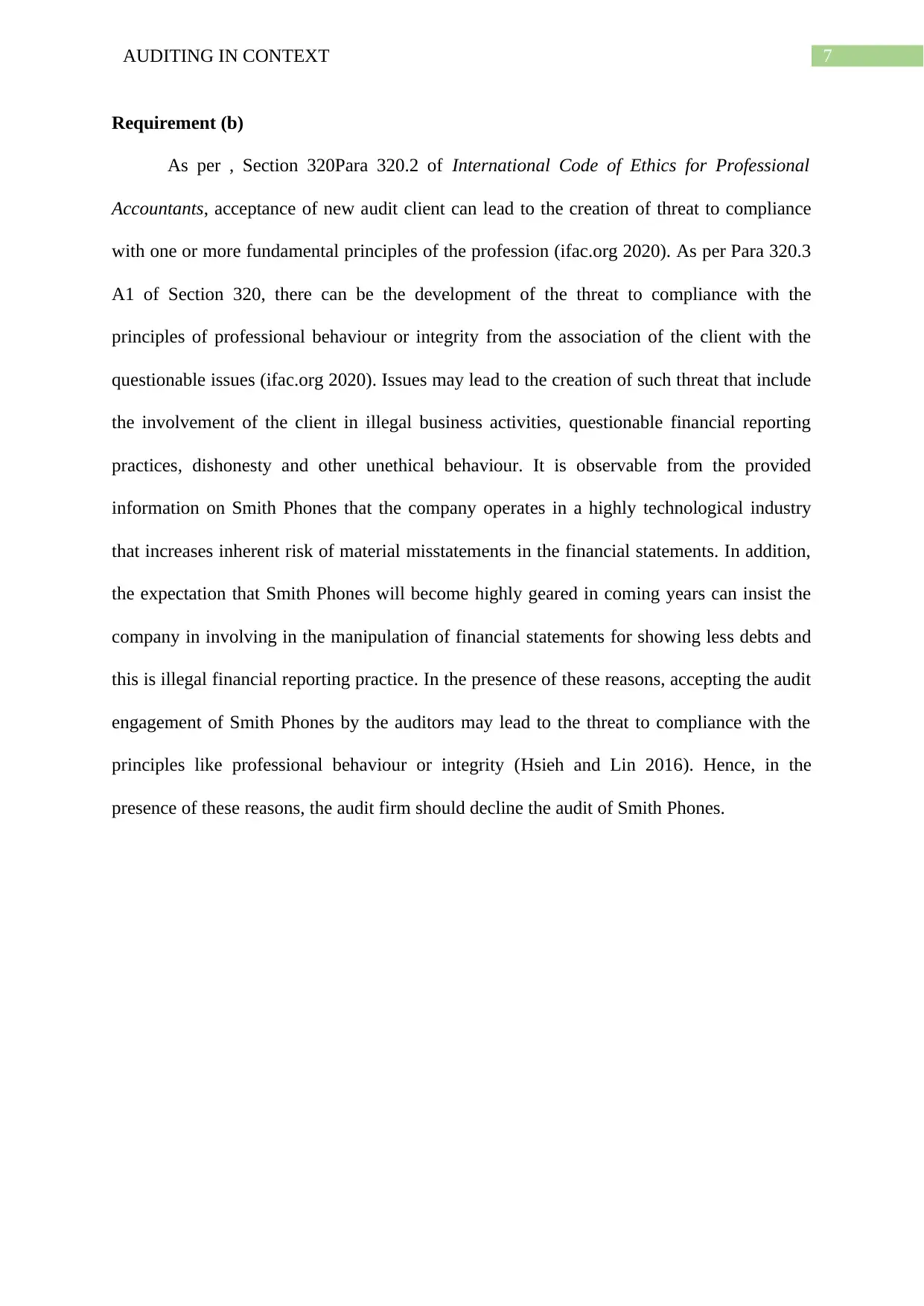
7AUDITING IN CONTEXT
Requirement (b)
As per , Section 320Para 320.2 of International Code of Ethics for Professional
Accountants, acceptance of new audit client can lead to the creation of threat to compliance
with one or more fundamental principles of the profession (ifac.org 2020). As per Para 320.3
A1 of Section 320, there can be the development of the threat to compliance with the
principles of professional behaviour or integrity from the association of the client with the
questionable issues (ifac.org 2020). Issues may lead to the creation of such threat that include
the involvement of the client in illegal business activities, questionable financial reporting
practices, dishonesty and other unethical behaviour. It is observable from the provided
information on Smith Phones that the company operates in a highly technological industry
that increases inherent risk of material misstatements in the financial statements. In addition,
the expectation that Smith Phones will become highly geared in coming years can insist the
company in involving in the manipulation of financial statements for showing less debts and
this is illegal financial reporting practice. In the presence of these reasons, accepting the audit
engagement of Smith Phones by the auditors may lead to the threat to compliance with the
principles like professional behaviour or integrity (Hsieh and Lin 2016). Hence, in the
presence of these reasons, the audit firm should decline the audit of Smith Phones.
Requirement (b)
As per , Section 320Para 320.2 of International Code of Ethics for Professional
Accountants, acceptance of new audit client can lead to the creation of threat to compliance
with one or more fundamental principles of the profession (ifac.org 2020). As per Para 320.3
A1 of Section 320, there can be the development of the threat to compliance with the
principles of professional behaviour or integrity from the association of the client with the
questionable issues (ifac.org 2020). Issues may lead to the creation of such threat that include
the involvement of the client in illegal business activities, questionable financial reporting
practices, dishonesty and other unethical behaviour. It is observable from the provided
information on Smith Phones that the company operates in a highly technological industry
that increases inherent risk of material misstatements in the financial statements. In addition,
the expectation that Smith Phones will become highly geared in coming years can insist the
company in involving in the manipulation of financial statements for showing less debts and
this is illegal financial reporting practice. In the presence of these reasons, accepting the audit
engagement of Smith Phones by the auditors may lead to the threat to compliance with the
principles like professional behaviour or integrity (Hsieh and Lin 2016). Hence, in the
presence of these reasons, the audit firm should decline the audit of Smith Phones.
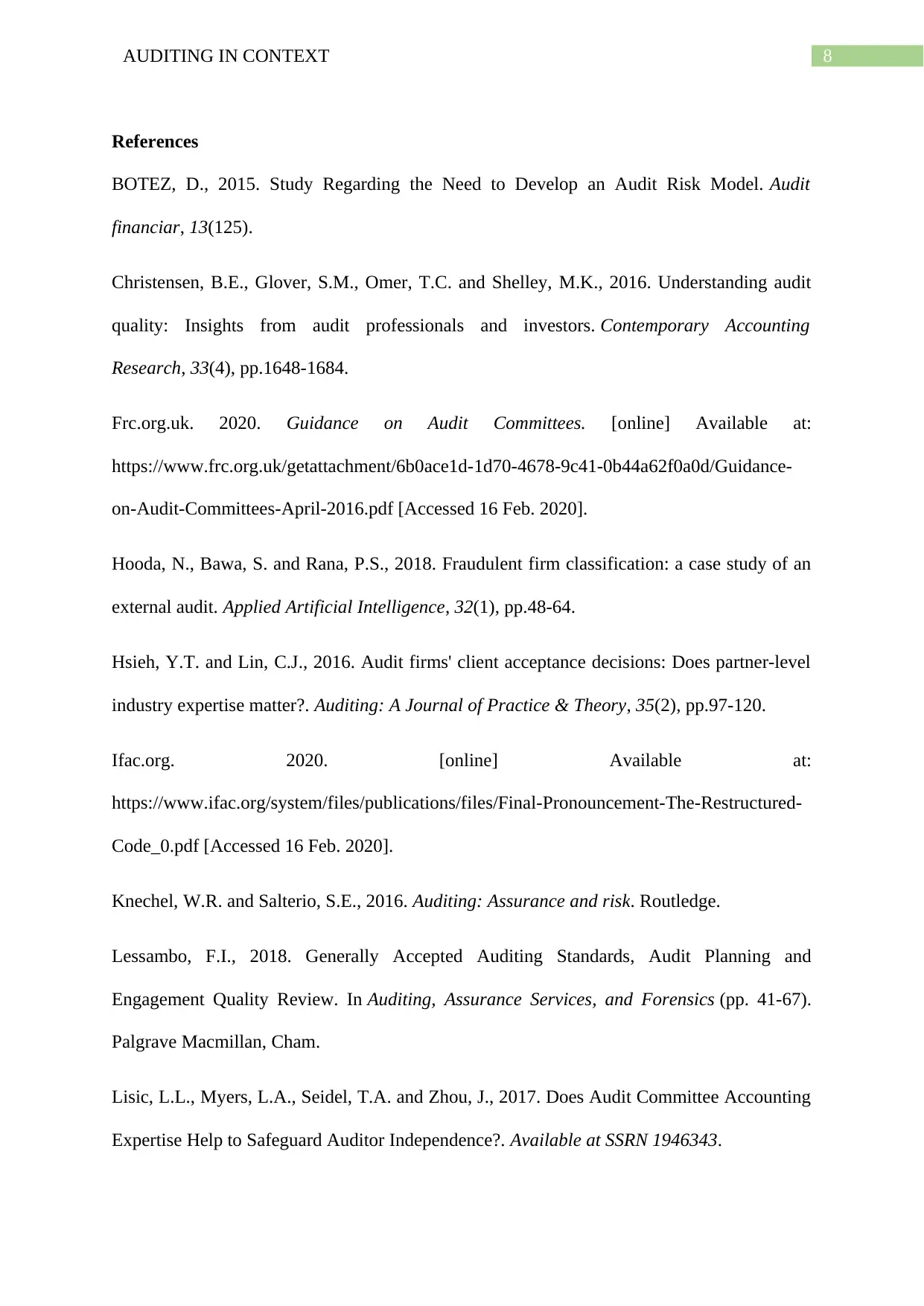
8AUDITING IN CONTEXT
References
BOTEZ, D., 2015. Study Regarding the Need to Develop an Audit Risk Model. Audit
financiar, 13(125).
Christensen, B.E., Glover, S.M., Omer, T.C. and Shelley, M.K., 2016. Understanding audit
quality: Insights from audit professionals and investors. Contemporary Accounting
Research, 33(4), pp.1648-1684.
Frc.org.uk. 2020. Guidance on Audit Committees. [online] Available at:
https://www.frc.org.uk/getattachment/6b0ace1d-1d70-4678-9c41-0b44a62f0a0d/Guidance-
on-Audit-Committees-April-2016.pdf [Accessed 16 Feb. 2020].
Hooda, N., Bawa, S. and Rana, P.S., 2018. Fraudulent firm classification: a case study of an
external audit. Applied Artificial Intelligence, 32(1), pp.48-64.
Hsieh, Y.T. and Lin, C.J., 2016. Audit firms' client acceptance decisions: Does partner-level
industry expertise matter?. Auditing: A Journal of Practice & Theory, 35(2), pp.97-120.
Ifac.org. 2020. [online] Available at:
https://www.ifac.org/system/files/publications/files/Final-Pronouncement-The-Restructured-
Code_0.pdf [Accessed 16 Feb. 2020].
Knechel, W.R. and Salterio, S.E., 2016. Auditing: Assurance and risk. Routledge.
Lessambo, F.I., 2018. Generally Accepted Auditing Standards, Audit Planning and
Engagement Quality Review. In Auditing, Assurance Services, and Forensics (pp. 41-67).
Palgrave Macmillan, Cham.
Lisic, L.L., Myers, L.A., Seidel, T.A. and Zhou, J., 2017. Does Audit Committee Accounting
Expertise Help to Safeguard Auditor Independence?. Available at SSRN 1946343.
References
BOTEZ, D., 2015. Study Regarding the Need to Develop an Audit Risk Model. Audit
financiar, 13(125).
Christensen, B.E., Glover, S.M., Omer, T.C. and Shelley, M.K., 2016. Understanding audit
quality: Insights from audit professionals and investors. Contemporary Accounting
Research, 33(4), pp.1648-1684.
Frc.org.uk. 2020. Guidance on Audit Committees. [online] Available at:
https://www.frc.org.uk/getattachment/6b0ace1d-1d70-4678-9c41-0b44a62f0a0d/Guidance-
on-Audit-Committees-April-2016.pdf [Accessed 16 Feb. 2020].
Hooda, N., Bawa, S. and Rana, P.S., 2018. Fraudulent firm classification: a case study of an
external audit. Applied Artificial Intelligence, 32(1), pp.48-64.
Hsieh, Y.T. and Lin, C.J., 2016. Audit firms' client acceptance decisions: Does partner-level
industry expertise matter?. Auditing: A Journal of Practice & Theory, 35(2), pp.97-120.
Ifac.org. 2020. [online] Available at:
https://www.ifac.org/system/files/publications/files/Final-Pronouncement-The-Restructured-
Code_0.pdf [Accessed 16 Feb. 2020].
Knechel, W.R. and Salterio, S.E., 2016. Auditing: Assurance and risk. Routledge.
Lessambo, F.I., 2018. Generally Accepted Auditing Standards, Audit Planning and
Engagement Quality Review. In Auditing, Assurance Services, and Forensics (pp. 41-67).
Palgrave Macmillan, Cham.
Lisic, L.L., Myers, L.A., Seidel, T.A. and Zhou, J., 2017. Does Audit Committee Accounting
Expertise Help to Safeguard Auditor Independence?. Available at SSRN 1946343.
⊘ This is a preview!⊘
Do you want full access?
Subscribe today to unlock all pages.

Trusted by 1+ million students worldwide
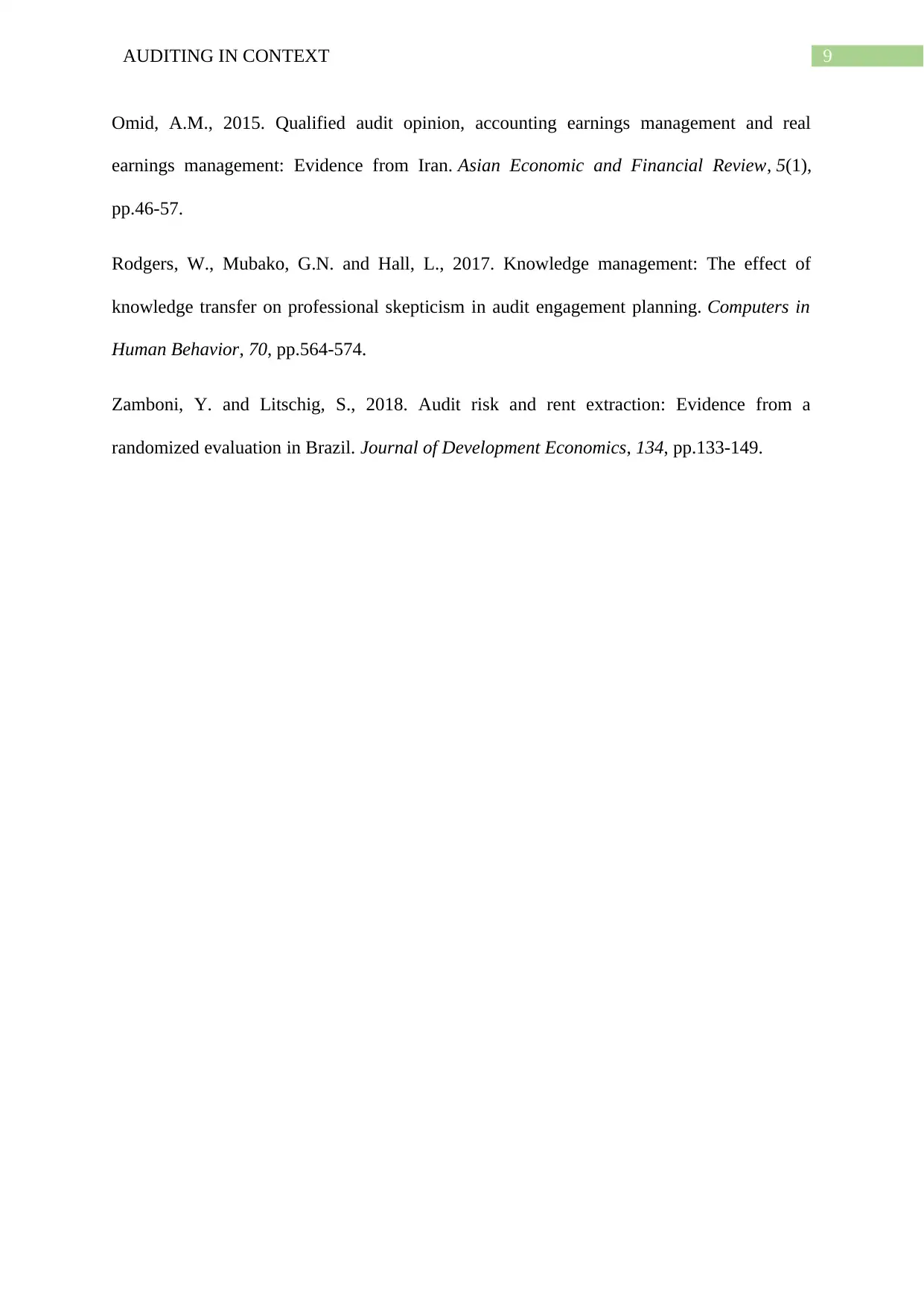
9AUDITING IN CONTEXT
Omid, A.M., 2015. Qualified audit opinion, accounting earnings management and real
earnings management: Evidence from Iran. Asian Economic and Financial Review, 5(1),
pp.46-57.
Rodgers, W., Mubako, G.N. and Hall, L., 2017. Knowledge management: The effect of
knowledge transfer on professional skepticism in audit engagement planning. Computers in
Human Behavior, 70, pp.564-574.
Zamboni, Y. and Litschig, S., 2018. Audit risk and rent extraction: Evidence from a
randomized evaluation in Brazil. Journal of Development Economics, 134, pp.133-149.
Omid, A.M., 2015. Qualified audit opinion, accounting earnings management and real
earnings management: Evidence from Iran. Asian Economic and Financial Review, 5(1),
pp.46-57.
Rodgers, W., Mubako, G.N. and Hall, L., 2017. Knowledge management: The effect of
knowledge transfer on professional skepticism in audit engagement planning. Computers in
Human Behavior, 70, pp.564-574.
Zamboni, Y. and Litschig, S., 2018. Audit risk and rent extraction: Evidence from a
randomized evaluation in Brazil. Journal of Development Economics, 134, pp.133-149.
1 out of 10
Related Documents
Your All-in-One AI-Powered Toolkit for Academic Success.
+13062052269
info@desklib.com
Available 24*7 on WhatsApp / Email
![[object Object]](/_next/static/media/star-bottom.7253800d.svg)
Unlock your academic potential
Copyright © 2020–2025 A2Z Services. All Rights Reserved. Developed and managed by ZUCOL.




